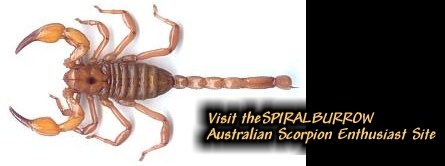

A BRIEF HISTORY:
CLASSIFICATION OF AUSTRALIA`S THERAPHOSIDAE.
The first Australian spider officially described was Gasteracantha fornicata,an araneomorph, by J.C.Fabricius in 1775. The first mygale discovered in Australia was Missulena occatoria (the Large mouse spider) in 1805 by Baron Charles Athanasi Walckenaer.
From about 1850 to 1900, the study of natural history reached new highs as numerous museums throughout Europe were erected. With these new museums came many evolutionary researchers, keen to identify new species from overseas. During this time many arachnoligists and entomologists from Europe descended down to Australia and named hundreds of new species. It was during this period that the majority of Australia`s theraphosids were named.
.
During two visits by the German Edward Daemel around 1866, spiders were collected from Cape York Peninsula, Western Australia, the Bass Strait and Sydney. The spiders from this collection were described and documented in Ludwig Koch`s Die Arachniden Australiens. It was in his1874 edition that the first Australian theraphosids were described. They were Ischnocolus lucubrans and Phrictus crassipes. Then in 1881 Tamerlan Thorell described an Australian theraphosid and called it Phrictus strenuus (now known as strenua). In 1887 the French entomologist Eugene Simon created the genus Phlogius, and in the same year, transferred Phrictus crassipes to his new genus.
In 1895 arachnologist Reginald Innes Pocock was to describe a new genus and species of theraphosid, found only in Australia. This was Selenotypus plumipes, possibly Australia`s largest spider.
In 1901 the English arachnologist Horatio R. Hogg described another two species of theraphosid from Australia. These two spiders were placed in the genus Selenocosmia (Anton Ausserer 1871) and were called S.stirlingi and S.vulpinus (now known as vulpina). Then in 1902 Hogg described a new genus and species, Selenotholus foelschei. These spiders were collected during Hogg`s residence in Australia from 1873 to 1892
In 1907 A.S. Hirst found what he believed to be a new theraphosid. He called it Selenocosmia stalkeri. In the same year, German arachnologist Embrik Strand described the theraphosid Selenocosmia subvulpina.
Another German, Carl Frederick Roewer, in his historical 1942 journal, Katalog der Araneae, split the worlds Selenocosmia genera into two groups: Oriental and Australian, incorporating New Guinea.
From what I can gather, not too much work was done on the Australian theraphosids until 1981, when Australian Dr. Barbara York Main placed Selenotholus foelschei in the genus Selenocosmia. In 1982 Main then transferred Phrictus strenua and Phlogius crassipes to the genus Selenocosmia. She also declassified Ischnocolus lucubrans (She found that Koch`s I.lucubrans holotype was actually a juvenile S.crassipes). Then in 1985 Main declassified Selenocosmia vulpina (S.vulpina was in fact selenocosmia crassipes) and Selenocosmia stalkeri (likewise, stalkeri was in fact Selenocosmia stirlingi). It is interesting to note that Ischnocolus lucubrans was actually described before Phrictus crassipes (albeit one page prior in Koch`s paper). This would normally mean that the first species name used to describe a type specimen is the one implemented. In 1985 Main explained that because of widespread usage it was logical to accept crassipes as the valid name.
In the same year Australian Dr Robert Raven restored Selenocosmia foelschei back to the genus Selenotholus. He surmised that because no other genus of Selenocosmiinae possessed a recurved foveal groove, this entitled generic recognition.
In 1995 German arachnologist Gunter Schmidt resurrected the genus Phlogius, transfering Selenocosmia crassipes and selenocosmia stirlingi back to Simon`s now defunct genus. He surmised that the stridulating organ of these specimens was different to the paratype of the genus (Selenocosmia javanensis). He also noted differences in the spermethecae and the absence of a third unpaired claw on the tarsi of leg four. In 2000 Raven rejected this proposal, placing stirlingi and crassipes back in the genus Selenocosmia. Schmidt had no basis for the restoration of Phlogius and the so-called paratype Selenocosmia specimen he studied held no nomenclatural status whatsoever. Neither did he show why S.stirlingi and S.crassipes differ from other species in the genus Selenocosmia (the presence of a third unpaired claw was never shown to be genus specific within the Selenocosmia). He also managed to perpetuate an error Roewer made in 1945 and repeated by Smith in 1992 regarding the distribution of S.crassipes. He listed the distribution as Australia and Papua New Guinea when the type locality is actually on the central Qld coast (determined by the Queensland Museum).
Phlogiellus were first described by Pocock in 1897 and were previously only believed to inhabit Java (P.asper Simon 1891 formerly Ischnocolus sp., P.atriceps Pocock 1897,), The Philippines (P.baeri Simon 1877 formerly Iscnocholus sp., P.bundokalbo Barrion and Litsinger 1995 formerly Baccallbrapo sp., P.insularis Simon 1877 formerly Ischnocolus sp., P.mutus L.Giltay 1935 formerly Neochilobrachys sp.), Malaysia to Lombok (P.inermis Ausserer 1871 formerly Ischnocolus sp.), The Solomon Is (P.nebulosus W.J.Rainbow formerly Ischnocolus sp.) , Burma (P.ornatus Thorell 1897 formerly Ischnocolus sp.), Myanmar (P.brevipes Thorell 1897 formerly Ischnocolus sp.), New Britain (P.bicolor Strand 1911), Nicobar Is. (P.subarmatus Thorrell 1891 formerly Neochilobrachys sp., Phlogiellus sp., and Ischnocolus sp.) and parts of Indo-china (P.subinermis L. Giltay 1934 formerly Selenocosmia sp.). Some years ago Dr Raven discovered some species of this genus living in the wet tropics of Qld. Research in describing these spiders is currently under way.

Figure 1. A Theraphosid from the genus Phlogiellus. Once detailed descriptions are done on this genus it may be found that these incorporate both the largest and the smallest species of Theraphosid in Australia.

